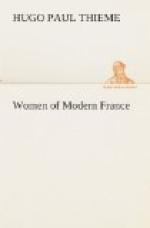There was another side to the nature of Mlle. La Guimard: during the terrible cold of the winter of 1768, she went about alone visiting the poor and needy, distributing food and clothing purchased with the six thousand livres given her by her lover, the Prince de Soubise, as a New Year’s gift. Her charity became so general that people of all professions and classes went to her for assistance—actors and artists to borrow the money with which to pay their debts, officers with the same object in view. To one of the latter to whom she had just lent a hundred louis and who was about to sign a note, she said: “Sir, your word is sufficient. I imagine that an officer will have as much honor as fille d’opera.”
Her performances at “Pantin” and her luxurious mode of life required more money than the two lovers were able to supply; therefore, another was accepted in the person of the Bishop of Orleans, Monseigneur de Jarente, who supplied her with money and other necessaries. In 1771 she decided to build a hotel with an elegant theatre which would comfortably seat five hundred people. The opening of this Temple de Terpsichore was the great event of the year (1772). All the nobility was there, even the princes of the blood, and the “delicious licenses of the presentation were fully enjoyed by those who were fortunate enough to obtain admission.”
Her costumes were of such taste and became so renowned that Marie Antoinette consulted her in reference to her own wonderful inventions; the dresses became known as the Robe a la La Guimard. Inasmuch as the management of the Opera supplied all gowns, the expense for this one artist was enormous, in 1779 amounting to thirty thousand livres for dresses alone. In 1785, being in financial straits, she sold her hotel on the Rue Chaussee-d’Antin by lottery, two thousand five hundred tickets at one hundred and twenty livres each. None of the salons of Paris could compare with hers in the “costliness of the crystal and the plate of her table service, in the taste and elegance of her floral decorations—choice exotics obtained from a distance, regardless of expense.”
After appearing at the Haymarket Opera House in London in 1789, Mlle. La Guimard decided to retire to private life, and married M. Despreaux, the ballet master, fifteen years her junior. During the Revolution the government ceased to pay pensions, and as she had saved very little of her wealth the two lived in the most straitened circumstances. Her fate was similar to that of the average woman of pleasure—forgotten, half-witted, stooping to any act of indecency to gain a few sous.
Such were the principal heroines of the stage, opera, and ballet; they were in harmony with the general state of that depraved society of which they were natural products; transitory lights that shone for but a short space of time, consumed by their own sensuous instinct, they were forgotten with death. The royal mistresses lived the same life and followed the same ideals, but exerted a greater and more lasting influence in the state.




